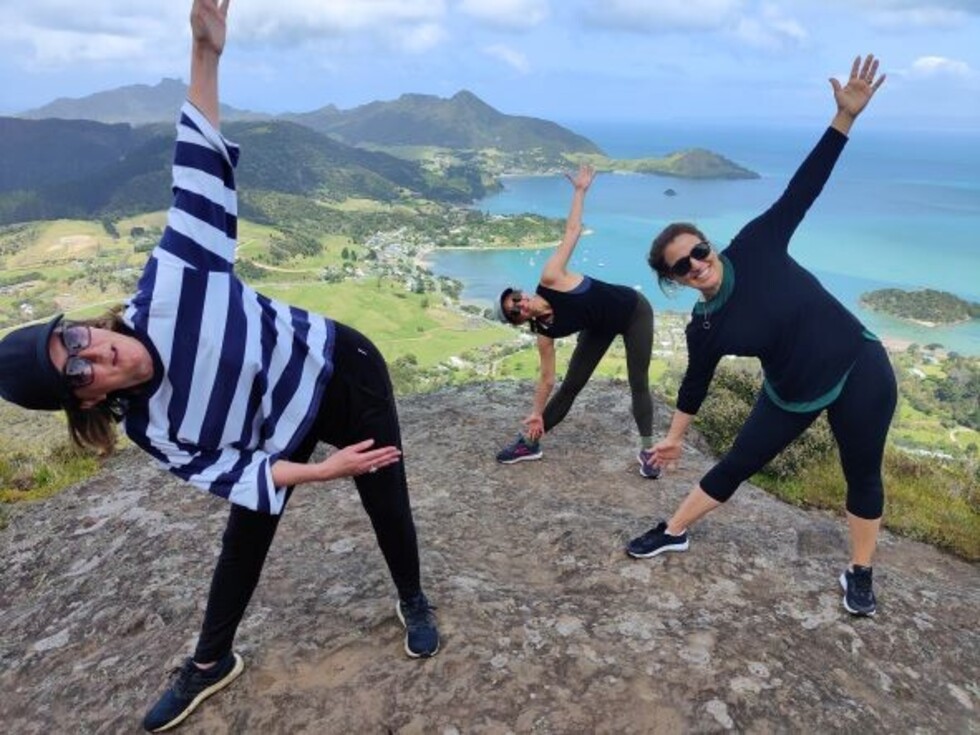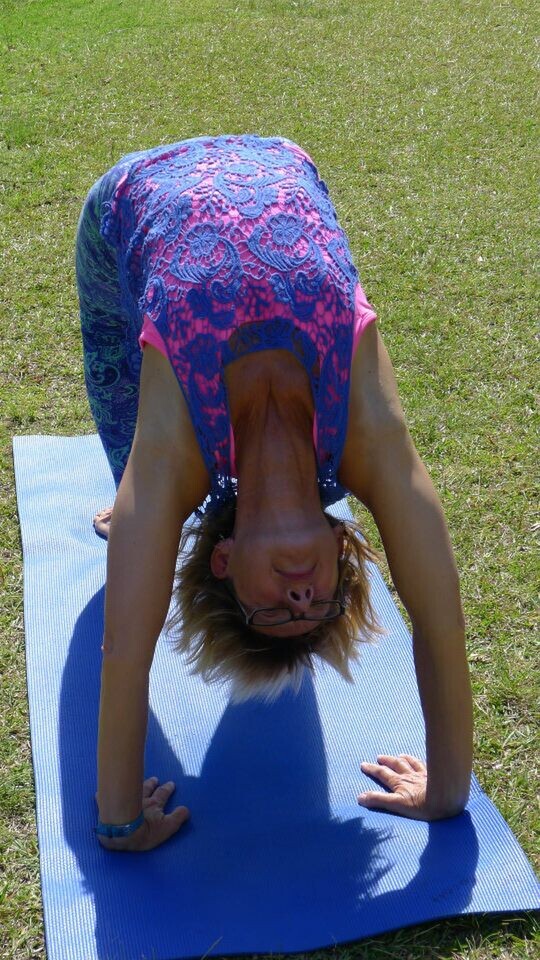The following article appears in New Zealand Yoga Scene Magazine.
One of my yoga teachers said “Yoga was once practiced by men in India to achieve spiritual enlightenment. Now it is practiced by Western women to improve their physical fitness and appearance”. As a Western woman, I would agree that my yoga practice began with the physical, to help me change my posture and allow me to participate in pain free physical activity. But the physical Asanas are only one of the eight limbs of a full yoga practice. By ‘practice’ I don’t mean the hour each morning I spend on my mat. Slowly, without me really noticing, yoga in its full 8-limbed glory crept into my daily life.
As a yoga teacher, I encourage my students to bring awareness to their daily activities. Work on those aspects of their fitness that they want to change not just during their hour with me, but all the time. Doing some small things all day becomes a habit that fits nicely in with our daily tasks. If the goal is a functional core and flat tummy, practice engaging the core and Mūla Bandha while driving or standing at the kitchen sink. It is not so hard to create good habits, but first comes awareness and intention. Take a critical look at the activities where you spend a lot of your time. Think about posture at the computer, for example. Try to bring alignment to the spine, and set an alarm to get up and stretch periodically.
A common complaint I hear is ‘I am too busy for exercise’. It’s easy for us to get caught up in the daily treadmill of life. We are all busy. It seems to me everyone is far busier now than ever before. Or has time sped up? One thing I know for sure is that we can’t go on like that forever. We need to stop and recharge the batteries. If we don’t, stress can build up (see my article about stress in YOGA SCENE issue 3 page 28 or on my blog). We become less productive at work, our relationships suffer and one day the battery may just go flat, creating the breeding ground for chronic illness. If you can’t find time to exercise, how will you find the time to be sick?
Which brings me to the limb of Yoga that has helped me through every crisis in my life. Meditation. Not long after I began taking yoga classes, my teacher suggested I learn Transcendental Meditation. It was the mid 70’s. I always felt I had been born too late, missing out on the flower power era. So I loved the idea of incense and offerings of fruit and flowers, chanting with a group of serene monk-like people. The reality of my meditation class was quite different from this, but I was introduced to the method that I would use for years to come to recharge my batteries, and provide me with my own personal hurricane hole. In meditation, I found somewhere I could retreat to when the winds of life were battering me.
Do I hear you saying “I can’t even find time to exercise and now you want me to spend 20 minutes a day meditating?” Here is where I ask you again to take a look at the activities you spend your time doing. Keep a log of everything – preparing meals, driving to work, watching TV, playing with the kids, activities at work, sleep, exercise, meditation, leisure activities, visiting friends – whatever you spend time doing. After a week, add it all up. Then consider this in relation to your personal priorities. I did this once and found that a huge portion of my day revolved around food – shopping, cooking, planning, eating, cleaning up. I love to cook but clearly I had taken this to obsessive levels. Time to change! My point is that it is possible to fit in the things we want if we engage in a little planning. There is that awareness and intention again. Are you really aware of how you spend your time, and have you considered what your priorities in life are lately? A mismatch can be a possible source of malcontent. And notice how much time you have spent recharging the batteries.
A basic way to recharge is with breathing exercises. Pranayama, the next limb of Yoga I will discuss, should possibly be the first to be mastered. All life would stop without the breath. Pranayama can be used as a meditation, and it most certainly is involved during the practice of the Asanas. “Learning to Breathe” may seem ridiculous, but just notice how often you hold your breath. As a personal trainer, I am always surprised how many new clients try to lift a weight while holding their breath. Our most instinctive reaction during times of anxiety, fear, and grief is breath holding. Next time you feel stressed, depressed or angry, just try taking a few deep breaths and notice the effect on your mood. Feeling tired? Try 5 minutes of this deep breathing practice. Oddly, the same practice can be done in bed to help you sleep.
Step 1. Lay on your back with the body relaxed and eyes closed. Place one hand on your belly and the other just below your collar bones.
Step 2. As you inhale, try to make the hand on your belly rise. Do this with the breath, not by pushing your tummy muscles up. Exhale gently allowing the belly to return. Repeat 5-6 times, relaxing more with each breath. Ideally the inhalation and exhalation should take about the same time. Mentally count to 4 or 5 for each inhalation and exhalation.
Step 3. Breathe into the belly, feeling the hand rise, then draw the breath up through the lungs to the top of the chest. Feel the top hand rise. Exhale down from the top of the chest, then down through the ribs and lungs and finally exhale from the belly, allowing the diaphragm to gently press up under the rib cage. Repeat for 5 minutes or as long as you feel comfortable with this breathing practice. If you do become anxious or find the breathing is difficult, return to normal breathing. You can resume the practice again when you have relaxed. I use a count of 6 heartbeats for each inhalation and 6 heartbeats for each exhalation. Begin with a count of 3 or 4 and work up. You may find that your heart and breathing slow as you practice, which means you are relaxing.
Taking time out each day to recharge through physical Asanas, meditation and Pranayama helps to relieve stress, improve relationships, increase our performance, and reduce the incidence of illness. It also brings about a change in our awareness and helps us to become mindful in all our activities. Thus Yoga creeps into our daily life.
The thing is, we never know when a personal tsunami will strike. How many people keep tinned food, bottled water and a torch handy just in case there is a civil emergency? The practice of Yoga in its full sense is our personal emergency kit. It keeps us strong to withstand the challenges, and helps us maintain a balance in our lives. The more we practice, the closer we come to Samadhi.
The 8 ‘Limbs’, Or Steps, To Achieving Spiritual Awareness
1. Yama : Universal morality
2. Niyama : Personal observances (such as cleanliness)
3. Asanas : Body postures – the physical Yoga Class
4. Pranayama : Breathing exercises
5. Pratyahara : Control of the senses
6. Dharana : Concentration and cultivating inner perceptual awareness
7. Dhyana : Devotion, Meditation on the Divine
8. Samadhi : Union with the Divine

